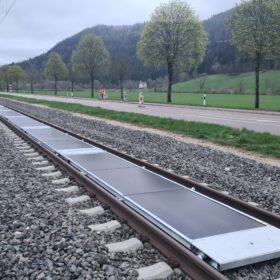Chinese PV Industry Brief: Polysilicon, solar module prices continue to slide
Polysilicon prices fell again this week amid weak market activity and elevated inventories, according to industry sources. Downstream wafer, cell, and module prices also continued to slide, with modules now trading as low as CNY 0.68 ($0.09)/W.
Swiss startup inaugurates removable PV plant on railway tracks
Swiss startup Sun-Ways says it has activated what it calls the world’s first removable solar plant on active rail tracks, with passenger trains set to run over the 18 kW installation from April 28.
Chemitek Solar launches new antistatic soiling mitigation coating
The Portuguese company said its new anti-soiling solution lasts for at least a year. It can be applied during routine cleaning operations by mixing it directly in the cleaning water.
How to combine photovoltaics with rainwater harvesting
Scientists have developed a system that harvests rainwater running off PV panels for household use or hydrogen production. Their analysis showed that, in the southern Sahel, the system can meet both the energy and water requirements for electrolysis, with surplus rainwater covering up to 50% of a household’s daily water demand.
Polysilicon prices decline amid growing short-term market pessimism
In a new weekly update for pv magazine, OPIS, a Dow Jones company, reports that prevailing pessimism in the global polysilicon market continues to intensify, with current conditions still favoring buyers to a certain extent, allowing them to retain a degree of leverage in negotiations.
Solex Energy to open 2 GW TOPCon cell plant in 2027
India’s Solex Energy has started working on its new 2 GW n-type tunnel oxide passivated contact (TOPCon) solar cell factory, with operations set to begin in early 2027.
Japanese scientists build bendable perovskite-silicon tandem solar cell with 26.5% efficiency
The tandem device is based on a bottom thin-film heterojunction cell that can bend and a top perovskite cell that can be manufactured with a low-temperature process to prevent damage. It achieved the highest efficiency ever recorded to date for a flexible perovskite-silicon tandem solar cell.
DAS Solar plans 3 GW solar module factory in France
Chinese manufacturer Das Solar says it will open its first European PV panel assembly plant in Mandeure, eastern France, by the end of 2025.
Solar-air-ground CO2 heat pump system for renewables maximization
Researchers in Italy have designed a novel carbon dioxide heat pump that can work with photovoltaic-thermal energy, a finned coil heat exchanger and a U-tube borehole heat exchanger. Their experiment has shown that the simultaneous use of at least two energy sources always results in improved system performance even with limited heat transfer areas.
Aisin Corporation starts perovskite solar PV outdoor trial
The Japanese automotive components and systems manufacturer began testing its proprietary organic perovskite solar modules in what will be a 30 kW outdoor field trial at one of its facilities in Anjo.










